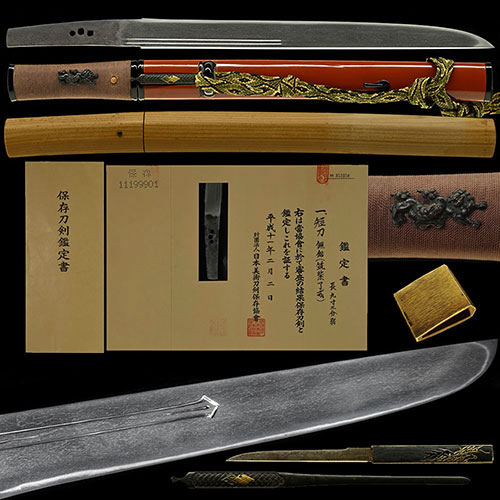
筑紫了戒 短刀Chikushi Ryokai Tanto
No.971446短刀 筑紫了戒 時代朱塗鞘合口拵付 南北朝後期 約640年前 映り立つ細直刃内反り短刀 九寸三分Tanto Chikushi Ryokai With Jidai Syunuri-saya Aikuchi Koshirae, Late Nanbokucho period, about 640 years ago, Utsuriatatsu, Hoso-suguha, Uchizori, Tanto 28.1cm
ご成約Sold
- 極めKiwame
- 筑紫了戒Chikushi Ryokai
- 登録証Registration
- 東京都 Tokyo 昭和50年4月10日 4/10/50(Showa)
- 時代Period
- 南北朝後期Late Nanbokucho period
- 法量Size
-
刃長 28.1cm (内反り) 反り 2.4cm
元重 0.56cm 茎長 10.6cm 重量 169gHachou 28.1cm (内反り) Sori 2.4cm
Moto-Kasane 0.56cm Nakago-Chou 10.6cm Weight 169g - 国Country
- 豊前Buzen
- 姿Shape
- 鎬造、平棟、庵棟、身幅やや細く、内反り。Shinogidukuri, Hiramune, Iorimune, Slightly narrow Mihaba, Uchizori.
- 鍛Kitae
- 板目肌に、杢目・流れ肌交じり、地沸微塵につき、地景入り、映り立つ。Itamehada, Mokume, Mixed Nagarehada, Jinie entered finely, Chikei entered, Utsuritatsu.
- 刃文Hamon
- 細直刃に、ほつれ掛り、小足入り、小沸つき、匂口明るい。Hoso-suguha, Hotsure-kakari, Small-Ashi entered, Small-Nie-tsuki, Nioikuchi is bright.
- 帽子Boushi
- 直ぐに小丸。Suguni-Komaru
- 茎Nakago
- 生ぶ、先栗尻、鑢目切、目釘孔三。Ubu, Sakikurijiri, Yasurimegiri, Mekugiana are three(3)
- ハバキHabaki
- 金着一重。Single Kinkise (Wearing a single layer of gold.)
- 拵Sword mounitings
- 朱漆塗鞘合口拵
法量
長さ98.0cm 反り4.3cm
説明
縁頭 赤銅般若図金色絵。 目貫 赤銅二匹獅子図。 小柄 赤銅魚子地雁に芦図金色絵。 笄 赤銅網代地四菱紋金色絵。 この刀の生ぶ拵で、ガタ付きなくピタリと収まります。Syu-Urushi-Nurisaya Aikuchi Koshirae
Length: 98cm
Sori: 4.3cm
Fuchigashira: Syakudou Hannyazu Kiniroe
Menuki: Syakudou Nihiki Shishizu(Two lions)
Koduka: Syakudou nanakoji Kari with Ashi-zu (Gold-colored painting of wild geese and reeds.)
Kougai: Syakudou Ajiroji Yotsubishimon Kiniroe (Red copper mesh base with four diamond crest and gold-colored painting.)
The Ubu-Koshirae for this sword fits perfectly without any rattling. - 彫物Carving
- 表に護摩箸、裏に素剣を彫る。Gomahashi is carved on the front and a plain sword is carved on the back.
- 説明Drscription
- 了戒は、鎌倉中期から末期にかけての来派の刀工で、名を九郎左衛門と称し、来国行の子と伝え、来国俊とは兄弟となる。了戒の門人が南北朝時代応安頃に京より豊前に移り、室町時代にかけて繁栄したが、この一派を筑紫了戒と呼称する。了戒宣能などと銘を切り、他に直能・能次・能貞・秀能などがおり、「能」を通字とした。この短刀は、身幅やや細く、内反り、の品の良い姿で、南北朝末期から室町初期の作と思われ、板目肌流れて、地沸微塵につき、映り立つ地鉄に、小足入る細直刃を焼く優品である。Ryokai was a swordsmith of the Rai school from the mid to late Kamakura period. His name was Kurozaemon, and he was said to be the son of Rai Kuniyuki and the brother of Rai Kunitoshi.
Ryokai's disciples moved from Kyoto to Buzen around the time of Ouan during the Nanbokucho period and flourished through the Muromachi period, and this school is called Chikushi Ryokai.
His name was written as Ryokai Nobuyoshi, and his other names included Naoyoshi, Noritsugu, Norisada, and Hidetaka, with "No" being the common character.
This Tanto has slightly thin Mihaba, Uchizori, a beautiful appearance. It is thought to have been made between the end of the Nanbokucho period and the beginning of the Muromachi period. Itamehada-nagarete, Jinie entered finely, Utsuritatsu Jigane, Small-Ashi entered with Hoso-Suguha, A masterpiece.



